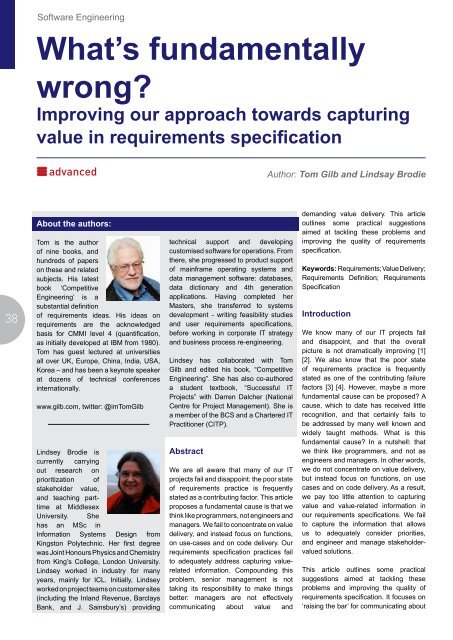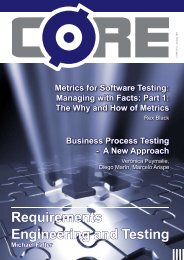Comparison of Change Management Systems
Comparison of Change Management Systems
Comparison of Change Management Systems
You also want an ePaper? Increase the reach of your titles
YUMPU automatically turns print PDFs into web optimized ePapers that Google loves.
38<br />
S<strong>of</strong>tware Engineering<br />
What’s fundamentally<br />
wrong?<br />
Improving our approach towards capturing<br />
value basic in requirements specification<br />
intermediate<br />
advanced<br />
About the authors:<br />
Tom is the author<br />
<strong>of</strong> nine books, and<br />
hundreds <strong>of</strong> papers<br />
on these and related<br />
subjects. His latest<br />
book ‘Competitive<br />
Engineering’ is a<br />
substantial definition<br />
<strong>of</strong> requirements ideas. His ideas on<br />
requirements are the acknowledged<br />
basis for CMMI level 4 (quantification,<br />
as initially developed at IBM from 1980).<br />
Tom has guest lectured at universities<br />
all over UK, Europe, China, India, USA,<br />
Korea – and has been a keynote speaker<br />
at dozens <strong>of</strong> technical conferences<br />
internationally.<br />
www.gilb.com, twitter: @imTomGilb<br />
Lindsey Brodie is<br />
currently carrying<br />
out research on<br />
prioritization <strong>of</strong><br />
stakeholder value,<br />
and teaching parttime<br />
at Middlesex<br />
University. She<br />
has an MSc in<br />
Information <strong>Systems</strong> Design from<br />
Kingston Polytechnic. Her first degree<br />
was Joint Honours Physics and Chemistry<br />
from King’s College, London University.<br />
Lindsey worked in industry for many<br />
years, mainly for ICL. Initially, Lindsey<br />
worked on project teams on customer sites<br />
(including the Inland Revenue, Barclays<br />
Bank, and J. Sainsbury’s) providing<br />
technical support and developing<br />
customised s<strong>of</strong>tware for operations. From<br />
there, she progressed to product support<br />
<strong>of</strong> mainframe operating systems and<br />
data management s<strong>of</strong>tware: databases,<br />
data dictionary and 4th generation<br />
applications. Having completed her<br />
Masters, she transferred to systems<br />
development - writing feasibility studies<br />
and user requirements specifications,<br />
before working in corporate IT strategy<br />
and business process re-engineering.<br />
Lindsey has collaborated with Tom<br />
Gilb and edited his book, “Competitive<br />
Engineering”. She has also co-authored<br />
a student textbook, “Successful IT<br />
Projects” with Darren Dalcher (National<br />
Centre for Project <strong>Management</strong>). She is<br />
a member <strong>of</strong> the BCS and a Chartered IT<br />
Practitioner (CITP).<br />
Abstract<br />
We are all aware that many <strong>of</strong> our IT<br />
projects fail and disappoint: the poor state<br />
<strong>of</strong> requirements practice is frequently<br />
stated as a contributing factor. This article<br />
proposes a fundamental cause is that we<br />
think like programmers, not engineers and<br />
managers. We fail to concentrate on value<br />
delivery, and instead focus on functions,<br />
on use-cases and on code delivery. Our<br />
requirements specification practices fail<br />
to adequately address capturing valuerelated<br />
information. Compounding this<br />
problem, senior management is not<br />
taking its responsibility to make things<br />
better: managers are not effectively<br />
communicating about value and<br />
Author: Tom Gilb and Lindsay Brodie<br />
demanding value delivery. This article<br />
outlines some practical suggestions<br />
aimed at tackling these problems and<br />
improving the quality <strong>of</strong> requirements<br />
specification.<br />
Keywords: Requirements; Value Delivery;<br />
Requirements Definition; Requirements<br />
Specification<br />
Introduction<br />
We know many <strong>of</strong> our IT projects fail<br />
and disappoint, and that the overall<br />
picture is not dramatically improving [1]<br />
[2]. We also know that the poor state<br />
<strong>of</strong> requirements practice is frequently<br />
stated as one <strong>of</strong> the contributing failure<br />
factors [3] [4]. However, maybe a more<br />
fundamental cause can be proposed? A<br />
cause, which to date has received little<br />
recognition, and that certainly fails to<br />
be addressed by many well known and<br />
widely taught methods. What is this<br />
fundamental cause? In a nutshell: that<br />
we think like programmers, and not as<br />
engineers and managers. In other words,<br />
we do not concentrate on value delivery,<br />
but instead focus on functions, on use<br />
cases and on code delivery. As a result,<br />
we pay too little attention to capturing<br />
value and value-related information in<br />
our requirements specifications. We fail<br />
to capture the information that allows<br />
us to adequately consider priorities,<br />
and engineer and manage stakeholdervalued<br />
solutions.<br />
This article outlines some practical<br />
suggestions aimed at tackling these<br />
problems and improving the quality <strong>of</strong><br />
requirements specification. It focuses on<br />
‘raising the bar’ for communicating about



